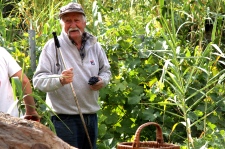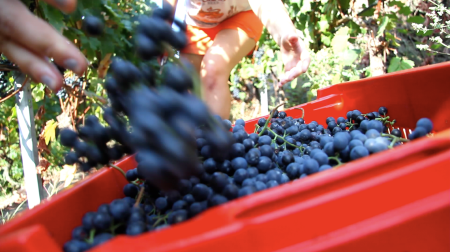
Alison Joy worked in a grape vineyard on the coast of Liguria, Italy which was devestated by flooding last October. Here’s how she describes her experience:

Saturday morning, we woke at 6:30; got ready; quickly dined on yogurt, cereal, pastries and hot coffee; and then took the train to Vernazza to meet Michele and Brittany. They led us to through the outskirts of town to our worksite, a local vineyard that had been damaged during the flood last year, and that was in dire need of some extra hands to pick. The owner had also been called in for surgery earlier than expected, leaving the ripe grapes on the vine. As we walked, we saw the metal skeletons of battered cars, half-staircases leading to nowhere, the bones of what were once ancient stone houses, and a bridge that had withstood one thousand years of damage, but had completely collapsed in the storm. Brittany showed us the house that she had almost finished restoring as a summer guest home by the river when it was ruined by the water and wind. Instead, the stones of the house lay in the shallow water below, despite the ten years she and her husband had put into purchasing and renovating the home.
 We spent the morning amongst the grape vines, snipping the ripe bunches with clippers and piling them into the red bins. The traditional method of farming in Cinque Terre is to cut flat terraces into the mountainside, and support them with rock walls. Cinque Terre is famous for its rock-building methods – the masons use almost no cement to keep them together, yet the walls have stayed in place for hundreds of years, and remained intact after the storm. We worked from the top of the hill downwards, finishing around noon. Upon seeing us all together, the 91-year-old owner of the vineyard exclaimed: “I’ve never seen so many beautiful girls on my farm at once – now I can die!” Morbid but cute.
We spent the morning amongst the grape vines, snipping the ripe bunches with clippers and piling them into the red bins. The traditional method of farming in Cinque Terre is to cut flat terraces into the mountainside, and support them with rock walls. Cinque Terre is famous for its rock-building methods – the masons use almost no cement to keep them together, yet the walls have stayed in place for hundreds of years, and remained intact after the storm. We worked from the top of the hill downwards, finishing around noon. Upon seeing us all together, the 91-year-old owner of the vineyard exclaimed: “I’ve never seen so many beautiful girls on my farm at once – now I can die!” Morbid but cute.











